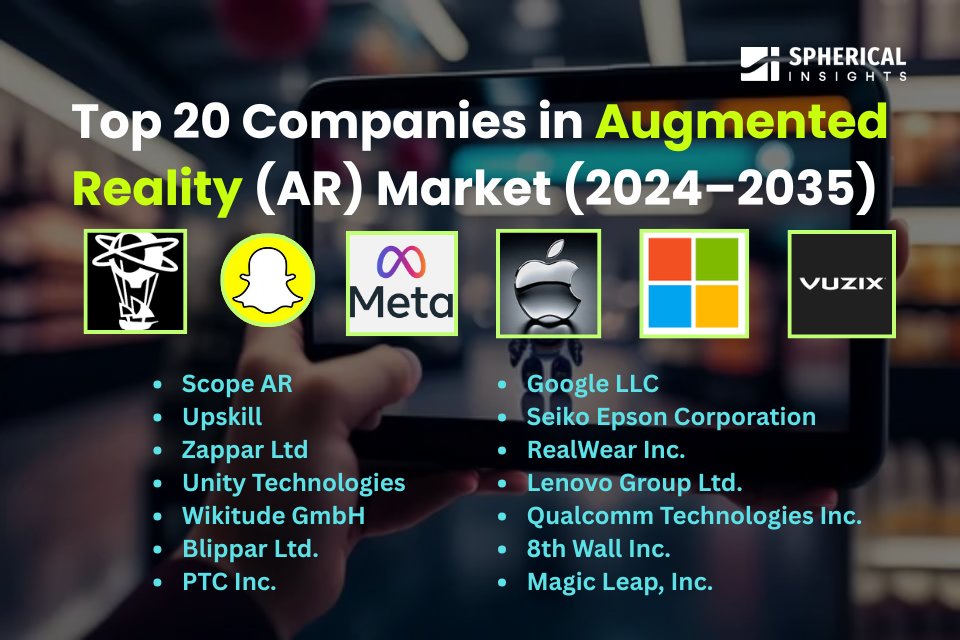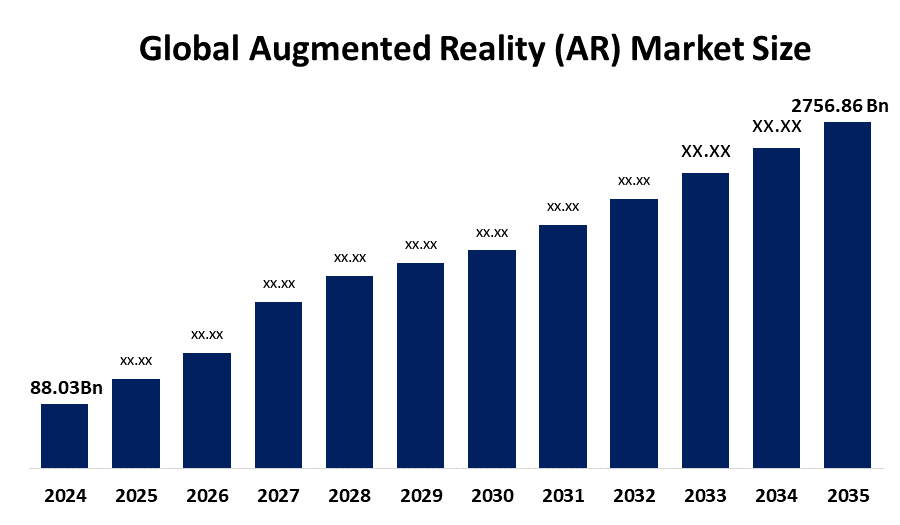
Top 20 Companies in Augmented Reality (AR) Market (2024–2035): Statistics Report Till 2035
RELEASE DATE: Jul 2025 Author: Spherical InsightsRequest Free Sample Speak to Analyst
Description
According to a research report published by Spherical Insights & Consulting, The Global Augmented Reality (AR) Market Size is projected to Grow from USD 88.03 Billion in 2024 to USD 2756.86 Billion by 2035, at a CAGR of 36.77% during the forecast period 2025–2035. The increasing number of mobile devices with augmented reality capabilities has changed how users engage with digital material. Real-time user interaction with goods and services is made possible by mobile augmented reality apps, which improve customer happiness by enabling individualized experiences.
Introduction
AR is being used more and more in the retail and e-commerce sectors to improve client experiences. the rising popularity of using augmented reality (AR) to digitally try on products, preview furniture in their homes, or see how things would look in real-world environments before making a purchase. This immersive shopping experience promotes the growth of the AR industry by increasing sales and consumer engagement. Furthermore, the growing use of AR in patient care, surgical visualization, and medical education is improving the accuracy and efficacy of medical treatments. Businesses are actively creating augmented reality (AR) technologies to help with complicated procedures and to train medical personnel. This greatly increases the need for AR solutions in this industry, which is propelling the market's expansion.
Key Market Trends:
Growing Need for Improved Customer Experience to Accelerate Market Development
The most crucial element for business growth in the modern world is preserving client relationships. The need for creative customer interaction solutions increased due to the decline in brand loyalty and the speed at which consumers switched between brands. Since augmented reality (AR) provides a personalized and engaging experience that contributes to increased customer satisfaction, many businesses are experimenting with technology to leave a lasting impression on their clients. For example, companies that use Adloid.in's online augmented tools for client engagement report a 200% increase in revenue, according to the business-to-business AR solution provider. A white paper from Infosys claims that companies that provide customized goods are seeing revenue growth that is six to 10 times faster. As a result, technology may greatly assist marketers in offering a customized consumer experience.
Growing Use of AR Technology in the Healthcare Sector Will Fuel Market Expansion
Immersion technologies are increasingly being used in the healthcare sector to assist healthcare professionals. Tasks can be completed more effectively because to the technology's realistic and immersive environment. In the past, doing complicated procedures was taxing due to the lack of knowledge. However, as AR provides surgeons with real-time notifications, the potential risk in procedures has decreased with its implementation. In a similar vein, the technology has the potential for dynamic and captivating medical education. For instance, in March 2022, the AR medical technology startup ImmersiveTouch announced a partnership with Mayo Clinics to provide surgeons with 3D holographic X-ray vision of patients' anatomy. Advanced AR platforms are improving the success rates of orthopedic surgery and providing doctors with seamless support as a result of the partnership.
Augmented Reality (AR) Market Size & Statistics
The market for augmented reality (AR) was estimated to be worth USD 88.03 Billion in 2024.
The market is going to expand at a CAGR of 36.77% between 2025 and 2035.
The Global Augmented Reality (AR) Market is anticipated to reach USD 2756.86 Billion by 2035.
North America is expected to generate the highest demand during the forecast period in the augmented reality (AR) market
Europe is expected to grow the fastest during the forecast period in the augmented reality (AR) market.

Regional growth and demand
Europe is expected to grow the fastest during the forecast period in the augmented reality (AR) market. The robust demand from sectors like manufacturing, education, and gaming & entertainment is the main driver of the market's expansion. Businesses in the UK, France, and Germany are using AR to improve product design and operational efficiency. Furthermore, Europe's growing emphasis on immersive technology and the metaverse spurs expansion in the media and aerospace & military industries.
North America is expected to generate the highest demand during the forecast period in the augmented reality (AR) market. The increasing use of AR in mobile applications, gaming & entertainment, and aerospace & military, spearheaded by firms like Apple, Inc. and Google LLC, is driving this trend in North America. There is also a growing need for augmented reality in education for improved medical education and remote support. The growing usage of AR for training and simulations by the US Department of Defense greatly aids in the growth of the market. The industry is also being driven by the quick development of augmented reality in e-commerce and retail, where virtual try-on solutions are becoming commonplace. Innovation in this field is still influenced by consumer demand for immersive experiences.
Top 20 Companies Leading the Augmented Reality (AR) Market
- Niantic, Inc.
- Snap Inc.
- Meta Platforms, Inc.
- Apple Inc.
- Microsoft Corporation
- Vuzix Corporation
- Scope AR
- Upskill
- Zappar Ltd
- Unity Technologies
- Wikitude GmbH
- Blippar Ltd.
- PTC Inc.
- Magic Leap, Inc.
- Google LLC
- Seiko Epson Corporation
- RealWear Inc.
- Lenovo Group Ltd.
- Qualcomm Technologies Inc.
- 8th Wall Inc.
- Niantic
Headquarters - San Francisco
Leading the augmented reality (AR) sector, San Francisco-based Niantic is well-known for its location-based AR games, such as Pokémon GO and Ingress. Developers may create immersive augmented reality experiences with the company's Niantic Lightship platform by utilizing spatial computing and real-world mapping. Niantic is also extending its presence in browser-based augmented reality by owning 8th Wall, a top WebAR development platform. Niantic is reinventing mobile augmented reality by fusing digital information with real-world surroundings, emphasizing geographic intelligence and real-time interaction. It is a key component of AR accessibility and scalability, with its inventions supporting billions of devices worldwide.
- Snap Inc
Headquarters – US
The parent company of Snapchat, Snap Inc., is a significant player in the augmented reality (AR) space, leveraging its Lens Studio platform to increase user engagement. Snap has made creating AR content more accessible with over 375,000 artists and billions of views on its AR lens. By providing rich augmented reality experiences, its Spectacles smart glasses push the limits of wearable technology. With the use of Snap's AR technologies, brands can create interactive campaigns that are extensively used in marketing, retail, and entertainment. Snap has made augmented reality a commonplace medium for digital connection and storytelling by incorporating it into regular social media use.
- Meta
Headquarters – US
Former Facebook subsidiary Meta has made significant investments in the augmented reality (AR) space with the goal of creating the immersive computing of the future. AR software platforms and hardware, such as Ray-Ban Meta smart glasses, are developed by its Reality Labs subsidiary. As a step toward seamless digital overlays, Meta's Project Nazare aims for complete AR integration without the need for phone screens. In order to integrate virtual and real worlds for social, gaming, and productivity applications, the company's augmented reality initiatives are at the heart of its metaverse strategy. The next generation of AR-powered digital ecosystems is being shaped by Meta, which has billions of users across its platforms.
- Apple
Headquarters - US
Apple is a market leader in augmented reality (AR), due to the introduction of the Apple Vision Pro headset and the ARKit framework. For iOS devices, ARKit lets developers create high-fidelity augmented reality experiences, and Vision Pro makes spatial computing accessible to the general public. Apple has improved functionality and user engagement by using augmented reality (AR) into retail tools, Maps, and Safari. Since Apple prioritizes privacy, performance, and user-friendly design, it is a reliable platform for AR innovation. Users' interactions with digital information in real-world settings are being revolutionized by Apple's integration of augmented reality into its ecosystem.
- Microsoft
Headquarters - US
Microsoft is a major pioneer in the augmented reality (AR) space, mostly due to its Mesh platform and HoloLens mixed reality device. HoloLens 2 provides enterprise-grade augmented reality technologies that facilitate hands-free collaboration and spatial visualization in the fields of manufacturing, healthcare, and education. Users can interact in shared virtual environments due to Microsoft Mesh's cross-device augmented reality capability. The business's investments in AI and cloud computing improve the scalability and integration of AR. Microsoft is a key actor in the development of immersive technology since it is promoting the use of AR in professional contexts with a strong enterprise focus.
Are you ready to discover more about the augmented reality (AR) market?
The report provides an in-depth analysis of the leading companies operating in the global augmented reality (AR) market. It includes a comparative assessment based on their product portfolios, business overviews, geographical footprint, strategic initiatives, market segment share, and SWOT analysis. Each company is profiled using a standardized format that includes:
Company Profiles
- Niantic, Inc.
- Business Overview
- Company Snapshot
- Products Overview
- Company Market Share Analysis
- Company Coverage Portfolio
- Financial Analysis
- Recent Developments
- Merger and Acquisitions
- SWOT Analysis
- Snap Inc.
- Meta Platforms, Inc.
- Apple Inc.
- Microsoft Corporation
- Vuzix Corporation
- Scope AR
- Upskill
- Zappar Ltd
- Others.
Conclusion
The global augmented reality (AR) industry is improving user engagement, personalization, and operational efficiency, which is quickly changing sectors. AR is becoming a major force behind the global digital transformation due to its increasing use in retail, healthcare, and education. Demand is increasing, especially in North America and Europe, due to technological breakthroughs and immersive experiences. As big firms develop new hardware, software, and cloud platforms, augmented reality (AR) has the potential to completely change how professionals and consumers engage with digital material.
Need help to buy this report?